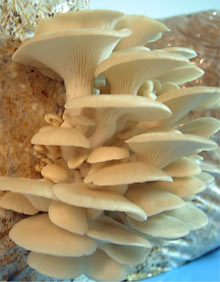 Pleurotus ostreatus, the oyster mushroom, is an active lignin degrader in the forests. Lignin is the second most abundant biopolymer on Earth and its breakdown is a necessary step for making cellulose (the most abundant carbon biopolymer) accessible to further enzymatic processes. The understanding of the whole-genome regulation of P. ostreatus lignocellulolytic enzymes would facilitate its use in in-situ bioremediation processes and other biotechnological processes.
Pleurotus ostreatus, the oyster mushroom, is an active lignin degrader in the forests. Lignin is the second most abundant biopolymer on Earth and its breakdown is a necessary step for making cellulose (the most abundant carbon biopolymer) accessible to further enzymatic processes. The understanding of the whole-genome regulation of P. ostreatus lignocellulolytic enzymes would facilitate its use in in-situ bioremediation processes and other biotechnological processes.
P. ostreatus is a saprophyte in the wild (i.e., it lives on dead or decaying matter). The comparison of its genome with that of other saprophytic, ectomycorrhizal (having filaments that grow between root cells), and pathogenic basidiomycetes would help in identifying specific gene sets for these different lifestyles. P. ostreatus occupies the third position in the worldwide market of industrially produced mushrooms. This fungus can grow easily on a variety of organic substrates, including agricultural wastes that P. ostreatus is able to recycle for animal foodstuff. The identification of the genetic basis of substrate colonization by P. ostreatus and of the induction of fruiting will facilitate the expansion of the range of agricultural wastes amenable to conversion using this fungus.
P. ostreatus also produces various secondary metabolites of medical interest. Knowledge of the genomics of P. ostreatus secondary metabolism will help to improve the production of these compounds. A number of quantitative trait loci controlling growth rate and industrial quality and productivity have been identified in P. ostreatus. The complete genome sequence will allow the analysis of the structure and mechanism of function of these quantitative genes.
Principal Investigators: Antonio Pisabarro, Lucia Ramirez (Public Univ. of Navarre), Allan C. Gathman (Southeast Missouri State Univ.), Francis Martin (INRA, France), Ursel Kues (Univ. of Göttingen), Yitzhak Hadar (Hebrew Univ. of Jerusalem), Christian Kubicek (Tech. Univ. of Vienna), Dan Cullen (Univ. of Wisconsin-Madison), Bernard Henrissat (Univ. Aix-Marseille I & II), Rytas Vlgalys (Duke Univ.), Juan Francisco Martin (Instituto de Biotecnologia de Leon).